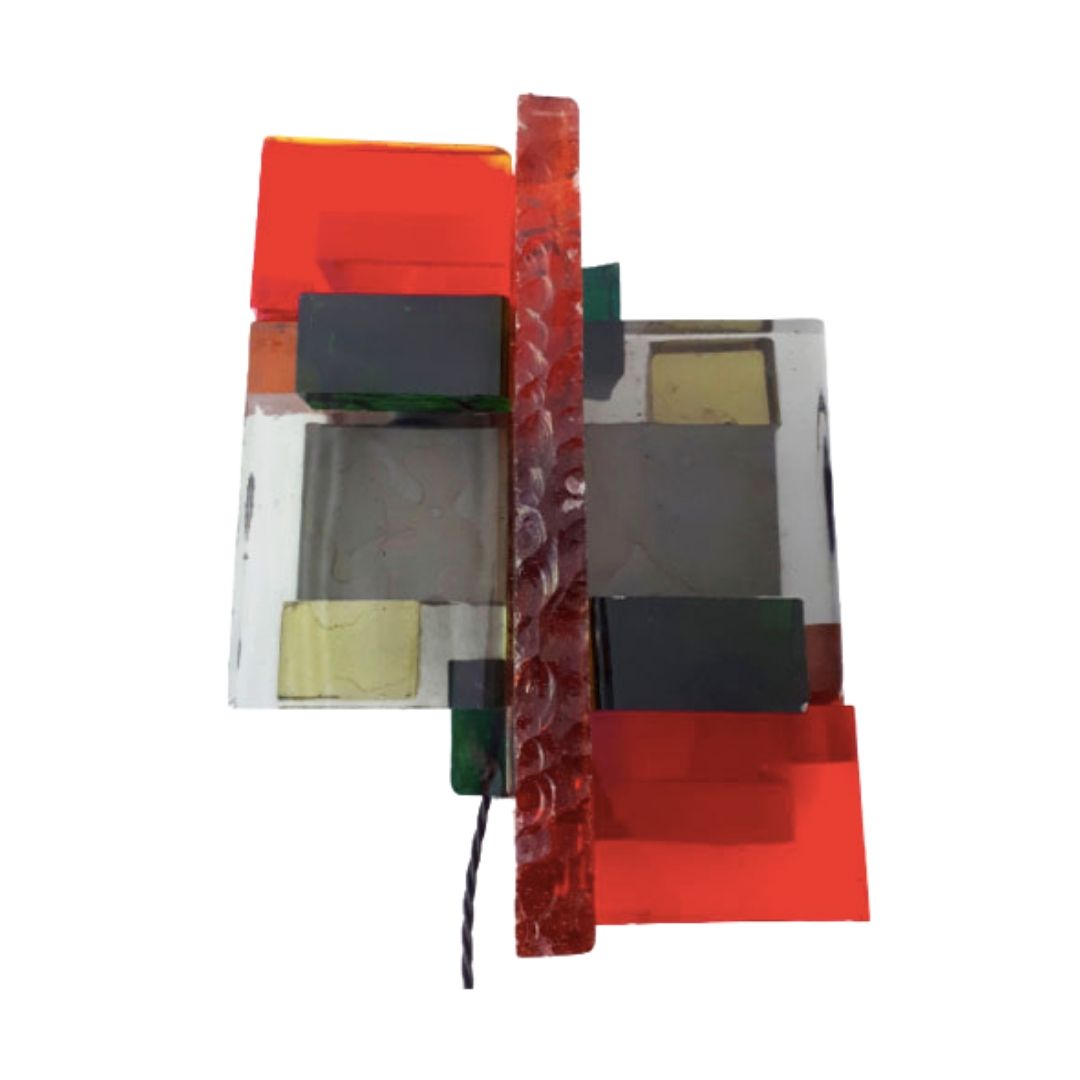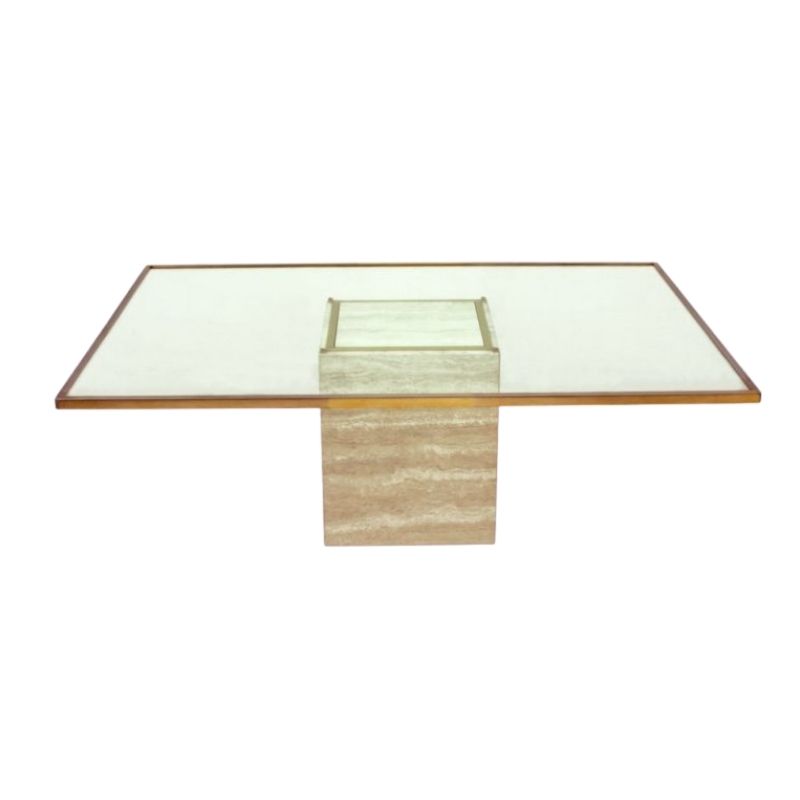I agree with most of the criticisms of Mr. Quinze's work. But again, I am not out to praise, or damn, any contemporary designer's work listed on DA. Rather, I am looking at this and other work and trying to understand if there is tendancy in recent design that is discernible. Clearly bad taste and lack of skill and talent are as timeless as their opposites. 🙂 But I'm looking for what is now, so that we might better understand what ought next to be. Or perhaps more appropriately expressed, we need to understand what is happening, so we can understand how to articulate a design philsophy that acts as foundation for designing more fitting solutions and for making us more able to distinguish what we propose from what is already.
I am not writing about a revolution, or evolution, or perpetuation of the status quo. Thinking in terms of anyone of these is too constraining for the moment. Rather, I am writing about, and hopefully encouraging, the designing of a contemporary design philosophy here at DA the same way we designed a flower vase.
It seems to me that design has tried designing everything but a design philosophy. When one looks back at the history of design, one often finds rather didactic approaches to developing design philosophy. They are edicts. Or epigrams. Or Heuristics. And they at least seem to be handed down from on high like Moses giving the Israelites the tablets. This polemical approach, or process, of arriving at design philosophy seems indicative of a youthful field, which epistemically speaking, design still is. In most mature, or even moribund fields, one often finds philosophies of fields/disciplines arrived at by the processes of those fields intermingled with the discipline of philosophy itself.
One does not find, at least it seems to me, design philosophies developed fundamentally through the design process that, say, Koen and others, have tried to expose the neophytes among us to through exercises like the flower vase experiment in internet collective design.
So whether I include one of the best designers, or one with some distinct shortcomings, like Mr. Quinze, they are being included intentionally to explore the broadest possible scope, at least initially, in the same way that we included all manner of design ideas in the early stages of the flower vase design process.
I am, in short, encouraging the design of a design philosophy.
I thinks its dangerous to...
I thinks its dangerous to know from where the well springs. I'm not sure why, perhaps I'm too much of a romantic.
Kants good on aesthetics though.
http://plato.stanford.edu/entries/kant-aesthetics/
i have
i have found much of what i wanted as it relates to your question from the book "cradle to cradle; remaking the way we make things" by William McDonough and Michael Braungart. i have followed much of the vase project, but in the case of a new design philosophy, this book has helped me personally by allowing me to move beyond what in my case might have been a reinventing the wheel excersise. this book covers areas that were always concerns of mine. central to my views is the need for a shift in design from that which benefits us individually to design that benefits us as a species and member of an ecosystem. and their solutions end up doing both. you can read a decent blurb for it by googleing the title. i would dearly love some feedback from my fellow design addicts about the ideas in this book. if i hadnt read it i would have beat DCW to his question some time ago. bill
HP and glassartist....Pt 1
Thank you for these observations. They trigger this response. I will most definitely read the book glass artist suggests.
FWIIW, I have read read what Plato, Aristotle, Kant, Michelangelo, Kandinsky and a few others have had to say about aesthetics and art. It is all very insightful and IMHO useful, especially Kandinsky on applied aesthetics, Michaelangelo on art and its politics, and Aristotle's Ars Poetica on poetry and art's purposes and possibilities.
For what can happen to art/philosophy and what can become of it, it is also good to contemplate the cascade from Socrates (Q&A for the ordering of knowledge), to Plato (institutionalizing knowledge into a more or less fascist bureacracy and academy), to Aristotle (ur-renaissance thinker), to Alexander the Great (ur renaissance man of action and nightmarish political realization of the cascade). They were all allegedly students of the one preceding the other. And Socrates probably had a heck of a teacher, probably his dad or mom, but ol' Soc was one of those well-spring types who wants to take the credit for being the prototype and probably avoided talking about where he learned his craft. 🙂
Now it is worth noting here that a design philosophy, as I conceive it, is not simply aesthetics (and I think we are on the same page on this). Philosophy is about why we live and do what we do and to what end we live it and do it. Philosophy is the pinnacle of the epistemological hierarchy, if you like trickle-down hierarchies, or its the foundation of the house of knowledge, if you like knowledge building metaphors, or it is the backbone infrastructure, if you are partial to digital/net centered metaphors.
But knowing what came before does not excuse any individual, group, tribe, nation, or generation from the obligation to choose philosophy. Not choosing is choosing the philosophy that is already operational.
With all due respect, one can never reinvent the wheel. One can only keep using the original, or alter it for better fit and application with current circumstances.
One can also unknowingly stumble about in the darkness and rediscover the wheel that came before, but as most complex processes are at least somewhat sensitively dependent on initial conditions, this rediscovery will often as not evidence distinct differences.
Since design did not specifically manifest as a field, or distinct discipline, prior to early the last century, I still think design COULD use a contemporary design philosophy that starts at the widest possible reconsideration of why one lives and what one does and builds upon the answers to these questions a rigorous epistemological framework (including aesthetics, politics, economics, etc.) regarding what design is.
No doubt in the DA vase project we sort of "reinvented the wheel" in some respects in the vase.
No doubt, an attempt to design a design philosophy, we would do some of that also.
HP and glassartist pt 2
But just as the vase evolved into a realization of something distinct and fitting for the circumstances, so to I think would a design philosophy.
Design philosophy requires both routine maintenance AND occassional bottom up reworking.
If you think the current design philosoply on requires some routine maintenance, then I am willing to take it up on that epistemic level.
But I sense a deeper, more foundational problem in design these days. I see a world in which the world is far more inundated with new materials, new technologies, new political-economic organizations, and new net centric social organizations that was the case when the last two really significant rebuilds of design philsophy emerged; they being the modernist and post modernist paradigms, with the former having some philosophical underpinnings and the latter having less, or less articulated in any case.
I see a world where robotics, nano and large scale have arrived, where electromagnetic waves can illuminate light bulbs without electric cords, where carbon fibers and carbon nanotubes can completely alter design tradeo off of strength vs. weight, where all communication can be reduced to wifeless, digital instrument in one's pocket. All of this and more is here now, or imminent. Once again everything has changed except the way we think, and add to that that we have WMD and weapons of mind coercion from the last century and newly emergent ones from this century that tempt aristocracies once resigned to representatiive government as a necessary evil, to thinking that we are on the verge of a bold, hideous neoroyalism and neoconservatism that can return the unwashed masses to their appropriate, beggared status, and you have a world in the throes of yet another vast transformation. Billions of new minds to educate or mind control, depending on your POV. Whole continents opening up to new real estate development. Soon an unprecedented numbers of newly educated minds contributing non linearly to the knowledge base. Technology is about to jump completely off the charts that we already think technology has jumped off from.
HP and glassartist...
I frankly do not see how designers, my favorite people in the whole world, the persons with the imagination and the technical skills that ideally suit them to step incrementally or whole hog into the unknown to bring from silence to light that which can be, do not see the need for designing a design philosophy, but again, being the village idiot here, perhaps I am just cannot grasp the gravities and realities shaping thought among design professionals today.
I do not think that a new design philosophy should, or would, threaten anyone's inner creativity, even its most romantic manifestations. Far from it. I would welcome to this attempt at designing a design philosophy the broadest possible feasible and strategic fit with circumstances today. We might just be primed for a romantic movement in design. Who knows? We are already into something I thought quite impossible--a kind of baroque, heavy modern revival.
Come one, come all, to the Designing a Design Philosophy Ball!
Here we come to the "Designing the Design Philosophy Ball"!.
What happened to the Design Philosophy project? Is it on hold? 🙂
We are still thinking about it.
I'm going to include two links with two ideas from Icon magazine (Thanks jonnymiller)
The fist one it,s like a good introduction.
I,ll transcribe it exactly as it is, worth it.
I won't put only the link. You know, sometimes links don,t work anymore. So this way we,ll preserve the information.(I hate when information disappears).
And the second is their proposition to their manifesto.
MANIFESTO - pt 1
The age of the manifesto is over. The grand ideologies are dead. History has ended. Relativism and apathy reign.
It's funny to think that only a decade ago all of those statements were considered credible enough to be in common currency. The Cold War was over, the American model of commerce had gone global, instead of political conviction we had political correctness. As we shall see, it was not a great time for manifestos. But what about now? These days, the mere mention of globalisation can trigger a flash mob of masked rioters, people use phrases like "clash of civilisations" and, most importantly, every malcontent on the planet can publish his or her rant on the internet. The manifesto is back!
Arguably, the original manifesto was carved by Him upstairs as a list of rules. What manifestos became, though, were political statements of intent ? notable examples include the US Declaration of Independence of 1776, and Marx and Engels' Communist Manifesto of 1848. They were serious and, in the latter case, potentially deadly documents until they were discovered by artists ? and then the fun started. Talk of our inalienable rights was replaced by the nihilistic ravings of insomniac bohemians. Artists, you see, can't be held accountable.
The golden age of the manifesto was during the high point of modernism. It all started with FT Marinetti's Futurist Manifesto of 1909, which proclaimed that art needed to reflect the speed and power of the machine age ? everything had to be new, new, new. "To admire an old painting is to pour our sensitivity into a funeral urn," wrote Marinetti. The Italian set the tone for a succession of other proclamatory documents by the Vorticists (1914), Dadaists (1916 and 1918) and Surrealists (1924). From then on, they had to be quasi-nihilistic, contradictory and nonsensical ("in principle I am against manifestos, as I am against principles" wrote Tristan Tzara in 1918). The manifesto was the language of the avant-garde, and, since it had to shock, was peppered with capitalisation and exclamation marks so that words could be incendiary devices ? little sound bombs mimicking the senseless destruction of the Great War.
A good manifesto needs to invoke violence because it demands change. At the same time, however, the manifesto writer needs charisma, a sense of humour and, of course, delusion. By the 1960s, the Situationists were predicting that everyone would become an artist, while Yves Klein was claiming the sky as his greatest work. "Birds must be eliminated," he wrote in 1961, because they were spoiling his blue.
Interestingly, the canonical architecture manifestos were rather pious, humourless documents. Adolf Loos' Ornament and Crime (1908) took all the fun ? along with the decoration ? out of building, while in Towards a New Architecture (1923) and then in the Athens Charter (1933), Le Corbusier preached purity ? standardised order over mayhem. Nevertheless, their visions enjoyed plenty of realisation.
MANIFESTO - pt 2
In the 1970s, Venturi Scott Brown's Learning from Las Vegas and Rem Koolhaas' Delirious New York (a "retroactive manifesto") celebrated rampant capitalism's spontaneous products and accepted contemporaneity. But there was a dip in a form after Prince Charles' A Vision of Britain (1989), closely followed by the Unabomber's manifesto (1995) and the Stuckist manifesto (1999), which stated that only painting could be art. By now, it seemed, the manifesto had been appropriated by killers and, even worse, reactionaries. Rearguardists!
In the early 21st century, there are as many potential manifestos as there are people ? the internet has seen to that. The web is a hotbed of pamphleteering, whingeing, enthusing and, above all, sharing. In the age of the corporate mission statement, when global conglomerates want you to buy in to their "vision" and use their products, the open-source, creative commons advocates are fighting to keep cyberspace a place where users can express their own vision. However, the internet scribes who most embody the radical spirit of the early manifestoers are the hackers ? brimming with pointless rage and as yet unrecognised creative genius.
By Justin McGuirk from Icon magazine.
From:
neye.com/articles/20070822_45
ONE manifesto by EACH contributor
Make only ONE manifesto-design philosophy it could be too difficult to join all the ideas.
We could do the same, introduce our "personal" manifesto. One for each.
And join all the manifestos then.
P.S:
I didn't wanted to read the 50 icon's manifestos, because I didn't wanted to be influenced.
I DID, but I wasn't influenced!. So don't worry, I know that many of your manifestos would be much better. (But I promise to change mine with the influence of yours).
P.S 2:
Well, if I have to start, and have to be the first that must "To turn to the front of the class"
I am already preparing the draft with some points of mine.
gustavo, this is wonderful stuff and...
I look forward to your manifesto (both verb and noun).
Manifesto dates to the mid 1700s as an intransitive verb in English meaning: to issue a manifesto. Let's manifesto? 🙂
Before that, manifesto dates to 1620 as a noun, according to one dictionary I looked at and means: "a written statement declaring publicly the intentions, motives, or views of its issuer."
Before that we have manifest, dating to the 1500s and meaning: a list of passengers or an invoice of cargo for a vehicle (as a ship or plane).
Before that we have manifest, dating to the 1400s and meaning: to make evident or certain by showing or displaying.
Manifesto seems to derive from the ancient Latin manifestus.
My only further point of clarification at this time would be that I would wish for us to design a manifesto and not just enunciate one. Or to think of manifesto as a verb, I would wish for us to design the way we manifesto.
Let's manifesto.
The intransitive verb is so much more fun and alive than the noun.
It is more fun to tango than to do the tango, if you know what I mean.
Likewise to talk of designing something is much more alive than talking of a design. The former is alive The latter is a fossil.
I suspect that the early modernists erred in issuing manifestos rather than manifestoing. 🙂
We can solve that problem by manifestoing about designing.
jumping off point
its been a while and i have reread the thread, so i am ready to throw out some basic ideas for discussion. my first idea is borrowed from many previous modern designers. it is a socialistic idea of wide access to design through low cost (efficiently produced) works. though there was much straying into luxury items, many started with this idea (among others). so we have a basic idea of doing good for humanity. the contemporary extension (and as far into the future as i can imagine) involves basic survival issues. it is clear we are wrecking the planet we live on, and i can think of no idea that could possibly take precedence over that for centering a design philosophy. which leaves me with only one real option to frame this design philosophy and that is not only "do no harm" but even more so design to heal our ills. an excellent example would be not to design any houses for heating season climates that do not heat themselves passively. every new dwelling that does not do this is basically a fuel swilling suv, regardless of size. also, our desire for luxury is the enemy here, as well as our ability to stick our heads in the sand. design, out of necessity will increasingly become a deadly serious business, and make most previous designers concerns look trivial by comparison. there is a bright side to this though. we will need all manner of clever folk designing ways out of our problems, and if our species lasts long enough, they will be seen as the true giants of design, with the modernists as semi-primitive footnotes and anyone working today in a modernist vein (most) making luxury items as harmful, as they should know better by now. dcw, have you read cradle to cradle yet? their approach is the happy, bright spot on these concerns, if you dont want to be depressed by these thoughts, by all means read it folks. there is hope yet.
If you need any help, please contact us at – info@designaddict.com









